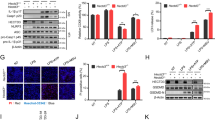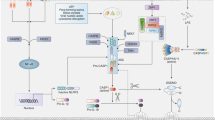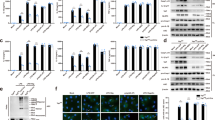Abstract
Aberrant inflammasome activation contributes to the pathogenesis of various human diseases, including atherosclerosis, gout, and metabolic disorders. Elucidation of the underlying mechanism involved in the negative regulation of the inflammasome is important for developing new therapeutic targets for these diseases. Here, we showed that Raf kinase inhibitor protein (RKIP) negatively regulates the activation of the NLRP1, NLRP3, and NLRC4 inflammasomes. RKIP deficiency enhanced caspase-1 activation and IL-1β secretion via NLRP1, NLRP3, and NLRC4 inflammasome activation in primary macrophages. The overexpression of RKIP in THP-1 cells inhibited NLRP1, NLRP3, and NLRC4 inflammasome activation. RKIP-deficient mice showed increased sensitivity to Alum-induced peritonitis and Salmonella typhimurium-induced inflammation, indicating that RKIP inhibits NLRP3 and NLRC4 inflammasome activation in vivo. Mechanistically, RKIP directly binds to apoptosis-associated speck-like protein containing a caspase-recruitment domain (ASC) and competes with NLRP1, NLRP3, or NLRC4 to interact with ASC, thus interrupting inflammasome assembly and activation. The depletion of RKIP aggravated inflammasome-related diseases such as monosodium urate (MSU)-induced gouty arthritis and high-fat diet (HFD)-induced metabolic disorders. Furthermore, the expression of RKIP was substantially downregulated in patients with gouty arthritis or type 2 diabetes (T2D) compared to healthy controls. Collectively, our findings suggest that RKIP negatively regulates NLRP1, NLRP3, and NLRC4 inflammasome activation and is a potential therapeutic target for the treatment of inflammasome-related diseases.
This is a preview of subscription content, access via your institution
Access options
Subscribe to this journal
Receive 12 digital issues and online access to articles
$119.00 per year
only $9.92 per issue
Buy this article
- Purchase on Springer Link
- Instant access to full article PDF
Prices may be subject to local taxes which are calculated during checkout






Similar content being viewed by others
References
Gross, O., Thomas, C. J., Guarda, G. & Tschopp, J. The inflammasome: an integrated view. Immunol. Rev. 243, 136–151, https://doi.org/10.1111/j.1600-065X.2011.01046.x (2011).
Misawa, T. et al. Microtubule-driven spatial arrangement of mitochondria promotes activation of the NLRP3 inflammasome. Nat. Immunol. 14, 454, https://doi.org/10.1038/ni.2550 (2013).
Guo, H. T., Callaway, J. B. & Ting, J. P. Y. Inflammasomes: mechanism of action, role in disease, and therapeutics. Nat. Med. 21, 677–687, https://doi.org/10.1038/nm.3893 (2015).
Davis, B. K., Wen, H. T. & Ting, J. P. Y. The inflammasome NLRs in immunity, inflammation, and associated diseases. Annu. Rev. Immunol. 29, 707–735, https://doi.org/10.1146/annurev-immunol-031210-101405 (2011).
Kayagaki, N. et al. Non-canonical inflammasome activation targets caspase-11. Nature 479, 117–U146, https://doi.org/10.1038/nature10558 (2011).
Kayagaki, N. et al. Noncanonical inflammasome activation by intracellular LPS independent of TLR4. Science 341, 1246–1249, https://doi.org/10.1126/science.1240248 (2013).
Khare, S., Luc, N., Dorfleutner, A. & Stehlik, C. Inflammasomes and their activation. Crit. Rev. Immunol. 30, 463–487, https://doi.org/10.1615/CritRevImmunol.v30.i5.50 (2010).
Fernandes-Alnemri, T. et al. The AIM2 inflammasome is critical for innate immunity to Francisella tularensis. Nat. Immunol. 11, 385–394, https://doi.org/10.1038/ni.1859 (2010).
De Nardo, D. & Latz, E. NLRP3 inflammasomes link inflammation and metabolic disease. Trends Immunol. 32, 373–379 (2011).
Yan, Y. Q. et al. Dopamine controls systemic inflammation through inhibition of NLRP3 inflammasome. Cell 160, 62–73, https://doi.org/10.1016/j.cell.2014.11.047 (2015).
Duewell, P. et al. NLRP3 inflammasomes are required for atherogenesis and activated by cholesterol crystals. Nature 464, 1357–U1357 (2010).
Martinon, F., Petrilli, V., Mayor, A., Tardivel, A. & Tschopp, J. Gout-associated uric acid crystals activate the NALP3 inflammasome. Nature 440, 237–241, https://doi.org/10.1038/nature04516 (2006).
Heneka, M. T. et al. NLRP3 is activated in Alzheimer’s disease and contributes to pathology in APP/PS1 mice. Nature 493, 674–678, https://doi.org/10.1038/nature11729 (2013).
Masters, S. L. et al. Activation of the NLRP3 inflammasome by islet amyloid polypeptide provides a mechanism for enhanced IL-1 beta in type 2 diabetes. Nat. Immunol. 11, 897–U1501, https://doi.org/10.1038/ni.1935 (2010).
Coll, R. C. et al. A small-molecule inhibitor of the NLRP3 inflammasome for the treatment of inflammatory diseases. Nat. Med. 21, 248–255, https://doi.org/10.1038/nm.3806 (2015).
Youm, Y. H. et al. The ketone metabolite beta-hydroxybutyrate blocks NLRP3 inflammasome-mediated inflammatory disease. Nat. Med. 21, 263–269, https://doi.org/10.1038/nm.3804 (2015).
Daniels, M. J. D. et al. Fenamate NSAIDs inhibit the NLRP3 inflammasome and protect against Alzheimer’s disease in rodent models. Nat. Commun. 7, 12504(2016).
Bernier, I. & Jolles, P. Purification and characterization of a Basic 23 Kda cytosolic protein from bovine brain. Biochim. Biophys. Acta 790, 174–181, https://doi.org/10.1016/0167-4838(84)90221-8 (1984).
Serre, L. et al. Crystal structures of YBHB and YBCL from Escherichia coli, two bacterial homologues to a Raf kinase inhibitor protein. J. Mol. Biol. 310, 617–634, https://doi.org/10.1006/jmbi.2001.4784 (2001).
Yeung, K. et al. Suppression of Raf-1 kinase activity and MAP kinase signalling by RKIP. Nature 401, 173–177 (1999).
Trakul, N., Menard, R. E., Schade, G. R., Qian, Z. H. & Rosner, M. R. Raf kinase inhibitory protein regulates Raf-1 but not B-Raf kinase activation. J. Biol. Chem. 280, 24931–24940, https://doi.org/10.1074/jbc.M413929200 (2005).
Lorenz, K., Lohse, M. J. & Quitterer, U. Protein kinase C switches the Raf kinase inhibitor from Raf-1 to GRK-2. Nature 426, 574–579, https://doi.org/10.1038/nature02158 (2003).
Al-Mulla, F. et al. Raf kinase inhibitor protein RKIP enhances signaling by glycogen synthase kinase-3 beta. Cancer Res. 71, 1334–1343, https://doi.org/10.1158/0008-5472.CAN-10-3102 (2011).
Yeung, K. C. et al. Raf kinase inhibitor protein interacts with NF-kappa B-inducing kinase and TAK1 and inhibits NF-kappa 13 activation. Mol. Cell. Biol. 21, 7207–7217, https://doi.org/10.1128/Mcb.21.21.7207-7217.2001 (2001).
Zeng, L. C., Imamoto, A. & Rosner, M. R. Raf kinase inhibitory protein (RKIP): a physiological regulator and future therapeutic target. Expert Opin. Ther. Target 12, 1275–1287, https://doi.org/10.1517/14728222.12.10.1275 (2008).
Al-Mulla, F., Bitar, M. S., Taqi, Z. & Yeung, K. C. RKIP: much more than Raf kinase inhibitory protein. J. Cell Physiol. 228, 1688–1702, https://doi.org/10.1002/jcp.24335 (2013).
Lin, W. L. et al. Raf kinase inhibitor protein mediates intestinal epithelial cell apoptosis and promotes IBDs in humans and mice. Gut 66, 597–610, https://doi.org/10.1136/gutjnl-2015-310096 (2017).
Gu, M. et al. RKIP and TBK1 form a positive feedback loop to promote type I interferon production in innate immunity. EMBO J. 35, 2553–2565, https://doi.org/10.15252/embj.201694060 (2016).
Lai, R. et al. Raf kinase inhibitor protein preferentially promotes TLR3-triggered signaling and inflammation. J. Immunol. 198, 4086–4095, https://doi.org/10.4049/jimmunol.1601672 (2017).
Lin, W. L. et al. Raf kinase inhibitor protein negatively regulates FceRI-mediated mast cell activation and allergic response. Proc. Natl Acad. Sci. USA 115, E9859–E9868, https://doi.org/10.1073/pnas.1805474115 (2018).
Lin, W. L. et al. RKIP mediates autoimmune inflammation by positively regulating IL-17R signaling. EMBO Rep. 19, e44951 (2018).
Man, S. M., Karki, R. & Kanneganti, T. D. Molecular mechanisms and functions of pyroptosis, inflammatory caspases and inflammasomes in infectious diseases. Immunol. Rev. 277, 61–75 (2017).
Caraffini, V. et al. Loss of RAF kinase inhibitor protein is involved in myelomonocytic differentiation an aggravates RAS-driven myeloid leukemogenesis. Haematologica 105, 375–386 (2020).
Reber, L. L. et al. Contribution of mast cell-derived interleukin-1 beta to uric acid crystal-induced acute arthritis in mice. Arthritis Rheumatol. 66, 2881–2891 (2014).
He, H. B. et al. Oridonin is a covalent NLRP3 inhibitor with strong anti-inflammasome activity. Nat. Commun. 9, 2550 (2018).
Huang, Y. & Rong, R. Tranilast directly targets NLRP3 to treat inflammasome-driven diseases. Eur. J. Immunol. 49, 1892–1892 (2019).
Vandanmagsar, B. et al. The NLRP3 inflammasome instigates obesity-induced inflammation and insulin resistance. Nat. Med. 17, 179–U214, https://doi.org/10.1038/nm.2279 (2011).
Strowig, T., Henao-Mejia, J., Elinav, E. & Flavell, R. Inflammasomes in health and disease. Nature 481, 278–286, https://doi.org/10.1038/nature10759 (2012).
Jin, J. et al. LRRFIP2 negatively regulates NLRP3 inflammasome activation in macrophages by promoting Flightless-I-mediated caspase-1 inhibition. Nat. Commun. 4, 2075. https://doi.org/10.1038/Ncomms3075 (2013).
Vande Walle, L. et al. Negative regulation of the NLRP3 inflammasome by A20 protects against arthritis. Nature 512, 69–73, https://doi.org/10.1038/nature13322 (2014).
Yang, C. S. et al. Small heterodimer partner interacts with NLRP3 and negatively regulates activation of the NLRP3 inflammasome. Nature Commun. 6, 6115. https://doi.org/10.1038/Ncomms7115 (2015).
Huai, W. W. et al. Aryl hydrocarbon receptor negatively regulates NLRP3 inflammasome activity by inhibiting NLRP3 transcription. Nature Commun. 5, 4738. https://doi.org/10.1038/Ncomms5738 (2014).
Lorden, G. et al. Lipin-2 regulates NLRP3 inflammasome by affecting P2X(7) receptor activation. J. Exp. Med. 214, 511–528, https://doi.org/10.1084/jem.20161452 (2017).
Mao, K. R. et al. beta-arrestin1 is critical for the full activation of NLRP3 and NLRC4 inflammasomes. J. Immunol. 194, 1867–1873, https://doi.org/10.4049/jimmunol.1401989 (2015).
Andersen, J. S. et al. Proteomic characterization of the human centrosome by protein correlation profiling. Nature 426, 570–574, https://doi.org/10.1038/nature02166 (2003).
Acknowledgements
We thank Professor John Sedivy for the Rkip-knockout mice, Professor Kam C. Yeung for the Rkipf/f mice and Dr Rongbin Zhou for the plasmids. This work was supported by the National Natural Science Foundation of China (81972733) and the Natural Science Foundation of Zhejiang Province (LY19H160048).
Author information
Authors and Affiliations
Contributions
X.W. and H.Y. designed the research; Q.Q., H.L., J.S., and Y.J. performed the research; X.W. and Q.Q. analyzed the data and wrote the paper.
Corresponding authors
Ethics declarations
Competing interests
The authors declare no competing interests.
Supplementary information
Rights and permissions
About this article
Cite this article
Qin, Q., Liu, H., Shou, J. et al. The inhibitor effect of RKIP on inflammasome activation and inflammasome-dependent diseases. Cell Mol Immunol 18, 992–1004 (2021). https://doi.org/10.1038/s41423-020-00525-3
Received:
Accepted:
Published:
Issue Date:
DOI: https://doi.org/10.1038/s41423-020-00525-3
Keywords
This article is cited by
-
Study of the inflammatory activating process in the early stage of Fusobacterium nucleatum infected PDLSCs
International Journal of Oral Science (2023)
-
Selective EZH2 inhibitor zld1039 alleviates inflammation in cisplatin-induced acute kidney injury partially by enhancing RKIP and suppressing NF-κB p65 pathway
Acta Pharmacologica Sinica (2022)
-
Activation of RKIP Binding ASC Attenuates Neuronal Pyroptosis and Brain Injury via Caspase-1/GSDMD Signaling Pathway After Intracerebral Hemorrhage in Mice
Translational Stroke Research (2022)



